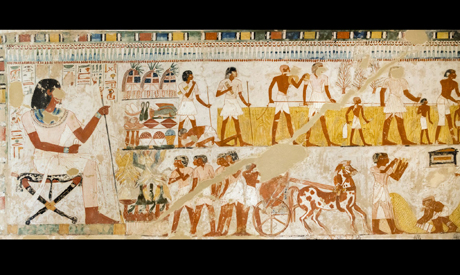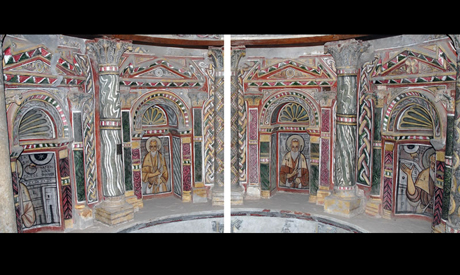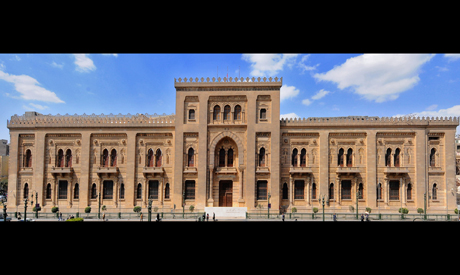Egypt: Virtual tourism on the rise
Virtual tours have become more and more important for Egypt's tourism sector in the wake of the coronavirus pandemic

The caption above is taken from a description of a scene showing the ancient Egyptian king Menna standing between a child and a woman with a destroyed face and is one of the captions used in a virtual tour of the king's tomb.
When virtual visitors click on the link for the virtual tour and enter the tomb, a long aisle covered with depictions on both sides appears. Each side has two white circles indicating clickable descriptions. Clicking on the ceiling of the virtual tomb produces the caption, "much of the elaborately patterned ceiling has been preserved, and the colours are still remarkably bright," for example.
Clicking on the floor towards the left leads to a room full of more depictions and information about the tomb.
Virtual tours have been on the rise worldwide as one way of trying to rescue the tourism industry in the wake of the travel restrictions intended to curb the spread of the Covid-19 pandemic. Egypt has jumped on virtual tours for the same reason, also using them to encourage people to visit the country in person when the pandemic is over.
About 100 million tourists visited Egypt between 2010 and the first quarter of 2020, according to the Central Agency for Public Mobilisation and Statistics (CAPMAS). According to the UN World Tourism Organisation (UNWTO), Egypt is among the world's fastest-growing tourist destinations, as the tourism sector witnessed 21 per cent growth in 2019, welcoming 13.6 million visitors.
Whereas experts expected that the number of tourists would reach more than 14 million in 2020, the pandemic has severely hindered Egypt's tourism. "After the lockdowns end, people will be hungry to travel again and to begin to cross borders. People feel as if they are in prison. When the airports reopen and tourism is back, we're expecting huge flows of tourists to come to Egypt," Assistant to the Minister of Tourism and Antiquities Enas Ehab told Al-Ahram Weekly.
Until tourism thrives again, the ministry is taking steps towards sustaining Egypt's tourism, however, including the organisation of virtual tours. The advisor to the minister of tourism and antiquities, Soha Bahgat, told Sky News Arabia TV channel that the supportive measures included institutions, investors, and entrepreneurs.
On 23 March 2020, the Ministry of Tourism and Antiquities shut down all archaeological sites across Egypt as part of preventive measures to control the Covid-19 pandemic. Although the Health Ministry carried out sanitisation measures, and workers at the sites received special training on protecting themselves, it was still too dangerous to allow visits.
Consequently, the authorities resorted to creative and practical solutions to cope with the lockdown.
On 3 April last year, the Ministry of Tourism and Antiquities cooperated with scientific and archaeological institutes to launch a series of free virtual tours around Egyptian museums and archeological sites.
A virtual tour is a sequence of photographs or video accompanied by text, sound effects, narration, or music to simulate a specific location. In 1994, UK Queen Elizabeth II opened an exhibition at the country's Dudley Castle showing a simulation of it in 1550 CE, for example, in one of the first ever virtual tours.
"I believe that there is no more appropriate time than today in the shadow of the Covid-19 pandemic to offer virtual tours of museums, archaeological sites, and safaris," Salah Marashi, a virtual tour creator and photographer, told the Weekly.
Today, tours whether 3D photographs or guidance videos, are shared on the ministry's website and social-media accounts like Facebook, Instagram, and Twitter. The slogan says "Experience Egypt from home. Stay home. Stay safe."
Descriptions are available in Arabic and English, but a spokesman from the media office of the ministry told the website Al-Monitor that there are plans to include material in all UN official languages, in other words English, Arabic, French, Chinese, Spanish, and Russian.

THE VIRTUAL TOURS: Organised in collaboration with the American Research Centre in Cairo, the first virtual tour explores the Menna Tomb in the Theban Necropolis. This is one of Luxor's most prominent tombs dating back to the 18th Dynasty.
A series of other video tours with narrated information on 20 pieces in the Egyptian Museum in Cairo's Tahrir Square was then made, including of such objects as the statue of king Akhenaten, the bust of queen Nefertiti, the gold collar of Psusennes I, and many more.
The Akhenaten statue, made of sandstone, was originally displayed in front of the temple of the god Aten in Karnak. It depicts the king with exaggerated features represented by narrow shoulders, a bulging belly, and full thighs and arms. He holds a wand and a flute. The statue also highlights the king's facial features, showing a long face and nose, narrow sloping eyes, and thick lips.
Similarly, the Nefertiti bust, made of quartz, shows the queen's elegant features.
The gold collar of Psusennes I was found around the neck of the mummy of king Psusennes I dating back to the 21st Dynasty. It is one of three necklaces belonging to the king made of 14-branched gold chains and ending in lotus flowers.
The virtual tour of the Egyptian Museum is of a building that now contains some 120,000 pieces, most of which are on display while the rest are in storerooms. Another highlighted museum of the virtual tours is the Museum of Islamic Art in Bab Al-Khalq in Cairo. This virtual tour was made to celebrate the 117th anniversary of its inauguration on 28 December last year.
The museum contains nearly 400 exhibits and a miscellaneous collection of Islamic artifacts dating back 12 centuries from countries such as Egypt, Saudi Arabia, and India.
The virtual tours also cover some of Old Cairo's heritage as well as archaeological sites from all over Egypt, including the Red Monastery, the Ben Ezra Synagogue, the Mosque-Madrasa of Sultan Barqouq, and the Kom Al-Shuqafa Catacombs.
The Red Monastery in Sohag in Upper Egypt is one of the most important monasteries in Egypt and was built in early Christian times. It was established by a saint called Bishoy in the early fourth century CE and is called the Red Monastery as red brick was used as primary material in its construction.
The monastery was exposed to fire twice, leaving only the church, fortress and architectural remnants behind. The fortress, dating back to the era of the Byzantine empress Helena, is an almost square building. It contains a group of units that the monks would occasionally hide in from attackers, as well as a church, warehouses, and water sources.
The Ben Ezra Synagogue is located on Mar Girgis Street in Old Cairo. It was originally a church before the Coptic Orthodox Church sold it in 882 CE to the Jewish community in Cairo. Some believe that it marks the site where the Prophet Moses prayed to God to lift the plague then afflicting the ancient Egyptians.
The synagogue is built in the basilica style. On its northern side, there is the geniza, or storehouse, which was discovered in 1896. This is a room closed on all sides where books and papers were once stored. They were transferred to Cambridge University in the UK shortly after their rediscovery.
The Mosque-Madrasa of Sultan Barqouq, one of the UK newspaper The Guardian's top 10 virtual tours of spectacular buildings around the world, was inaugurated in 1386 CE in Al-Muizz Street in Islamic Cairo. It is an architectural masterpiece with distinctive decorative elements including the use of colourful marble cladding and inscriptions of Quranic verses, indicating the name of the builder and the date of creation in Islamic naskhi script.
The Kom Al-Shuqafa Catacombs in Alexandria are among the best-preserved monuments from the Roman era in Egypt. They bring together a mixture of ancient Egyptian, Roman, and Greek cultures.
Thus, the ministry's virtual tours are not limited to one type of site, but extend to Pharaonic, Coptic, Islamic, and Jewish landmarks in Egypt. "The virtual tours target both international tourists and Egyptians. They serve the double purpose of promoting Egyptian tourism nationwide and increasing Egyptians' awareness of their own civilisation," a spokesman from the media office of the ministry told Al-Monitor.
The virtual tours can also help to raise awareness even when present circumstances change. Feedback has been very positive from both Egyptian and international tourists, the spokesman declared.
"Virtual tours are a great opportunity, and they can let the world see our awesome treasures as an invitation to people all over the world to visit Egypt's heritage sites," Angelina Gamal, a tourist guide, told the Weekly.

THE GRAND EGYPTIAN MUSEUM: The lockdown has also affected the Grand Egyptian Museum's (GEM) inauguration, which has been postponed to mid-2021, as announced by President Abdel-Fattah Al-Sisi this year.
In the meantime, the Ministry of Tourism has cooperated with the Ministry of Information to produce a new tour of the GEM and its Restoration Laboratory. The museum is the largest in the world and is dedicated to Egyptian civilisation from prehistoric until Greek and Roman times.
Overlooking the Pyramids on the Giza Plateau, the GEM will house an educational centre, a handicrafts centre, classrooms, a children's museum, and an area dedicated to solar boats. Covering an area of 18,000 square metres, 12 exhibition halls will display the ancient Egyptian civilisation.
The GEM will display more than 49,000 artifacts, including the complete collection of objects from the golden boy-king Tutankhamen's tomb for the first time. This includes more than 5,000 pieces, all exhibited in two halls of the GEM.
Other halls will show archaeological discoveries from the last two years. One hall, dedicated to the Asasif cache, will exhibit artifacts found by an Egyptian archaeological mission in the Luxor governorate in 2019.
Thirty-two closed sealed coffins found in December 2020 and belonging to priestesses and priests of the 22nd Dynasty will also be displayed. This discovery is one of the most significant ever made in Saqqara, and it includes 100 wooden coffins, gold masks, 42 wooden statues, and the coffins of senior statesmen and priests in addition to mummies of cats, lions, and crocodiles dating back to 2500 BCE.
All the coffins are decorated with hieroglyphic inscriptions and masks on the mummies' faces. The items were found in good condition, untouched by tomb robbers.
A virtual tour of the GEM shows parts of the museum's architecture and displays in order to promote the institution during the pandemic and before its grand opening.
While such virtual tours would not have existed had it not been for the coronavirus outbreak, they have been playing a very significant role in promoting Egypt's tourism abroad. Mohamed Al-Masoud, a member of Egypt's parliamentary committee on tourism and civil aviation, told Al-Monitor that virtual tours were one of the positive changes that have emerged from the crisis.
"The tourism sector is usually the hardest hit by crises and turbulence. But modern technology has now offered alternatives, [as] the virtual tours were launched during the coronavirus crisis, but they will last even after this crisis. They are one of the ministry's vehicles to promote tourism to Egypt," Al-Masoud said.
In addition to the virtual tours, there are also other campaigns to meet the demands of the tourism market. "We used to depend on Europe, which is closed now, so we have to find alternatives, especially as we're approaching the summer season," Ehab said.
In the meantime, the Ministry of Tourism and Antiquities intends to keep its virtual tours free of charge. "But we're studying different solutions and visions. [For example], we have got many offers to use archaeological sites to showcase products in a virtual reality theme, like [showcasing] paintings in the Citadel," it said.

WORLD MUSEUMS: Virtual tours are also taking off in other countries, opening the door to evaluations of the Egyptian versions.
Ministry officials "are trying their best to be as advanced in terms of technology as other countries. We see this from the virtual tours of Luxor tombs and other museum virtual tours," Gamal said.
Even so, there are still famous museums worldwide that do not offer virtual tours.
But "this technology has become one of the basics for any Website concerned with providing archaeological information in a different way from regular photographs with descriptions," Marashi said.
Meanwhile, the Google Arts and Culture Museum collection provides street views and virtual tours of cultural heritage sites worldwide. Founded in 2007 and part of the technology used for Google Maps and Google Earth, Google Street View now offers interactive panoramic views of streets and archaeological sites.
Google Arts and Culture offers virtual tours of 2,500 museums and galleries around the world. Virtual tours are available for the British Museum, which features thousands of artifacts, including the famous Rosetta Stone and Egyptian mummies. The Musée d'Orsay in Paris, also available as a virtual tour, features artworks from French artists Monet, Cézanne, and Gauguin.
Germany's biggest museum, the Pergamon Museum in Berlin, offers a virtual tour of the Pergamon Altar, the Ishtar Gate of Babylon, and other items. The Van Gogh Museum in Amsterdam offers a virtual tour of 200 paintings, 500 drawings, and over 750 personal letters by artist Vincent van Gogh.
The Guggenheim Museum in New York is included, featuring western artworks from the impressionist, post-impressionist, modern and contemporary periods. The Rijksmuseum in Amsterdam features the works of Vermeer and Rembrandt. The J. Paul Getty Museum in Los Angeles features paintings, drawings, sculptures, manuscripts, and photographs. The Louvre in Paris also offers virtual tours on its website.
No one has a clear idea of how tourism will look after Covid-19. Some people claim virtual tours could be the future of tourism, while others disagree. "Part of the experience is to deal with the people of the country, and find out more about the culture, the food, the languages, even walk in the streets." Ehab said. These things cannot be had on a virtual tour.
Whether they will be the future of tourism or just a part of it, virtual tours are not just a port in a storm. They are very much needed at the current time, especially for Egypt.
"We have very good potential. Our position is better than that of competitors. This is our chance to attract as many tourists as we can," Ehab said. "The purpose is to maintain our connection with tourists and to let them know we're still there."
*A version of this article appears in print in the 1 April, 2021 edition of Al-Ahram Weekly
-- Sent from my Linux system.
No comments:
Post a Comment